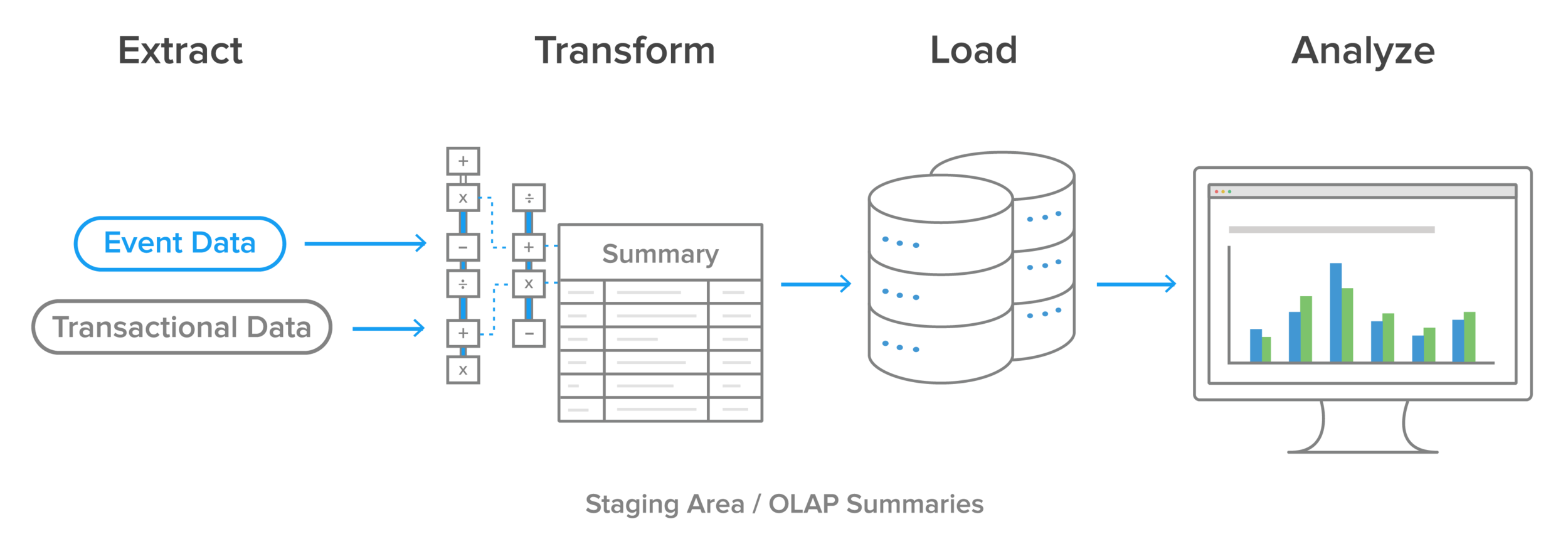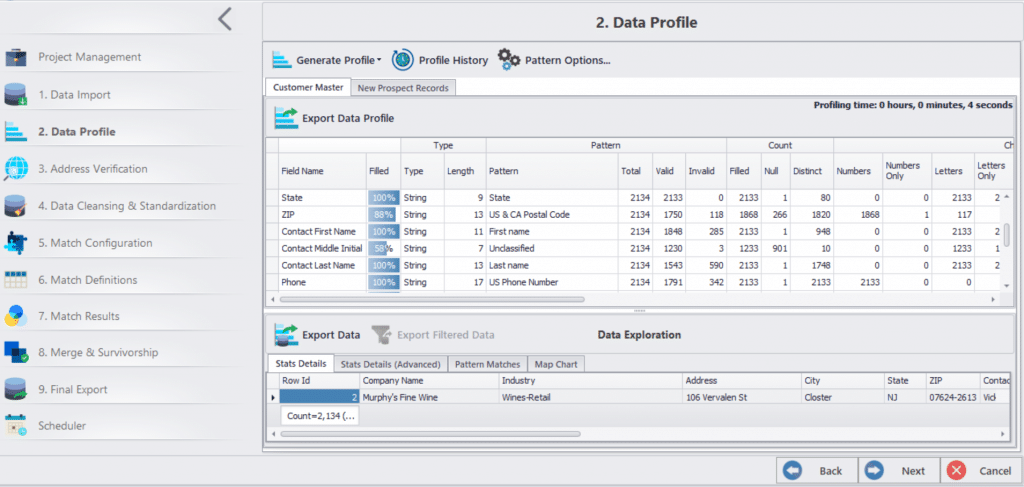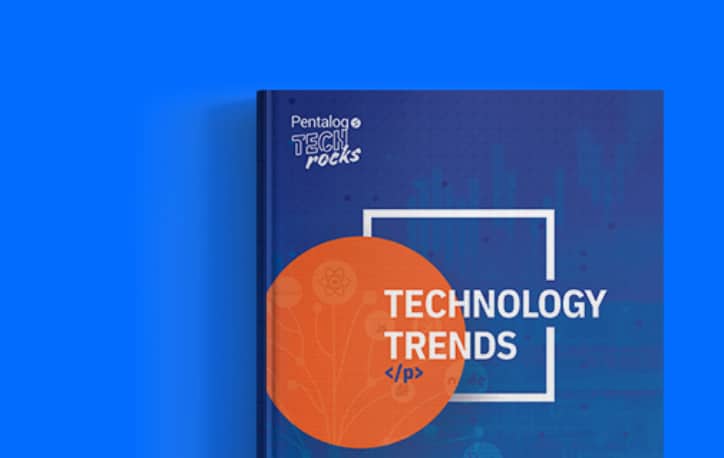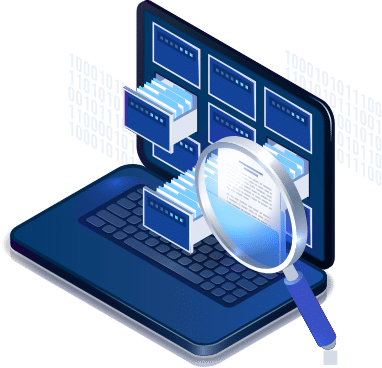What if the very process you rely on to manage your data is holding your business back?
Extracting meaningful insights from the flood of data modern businesses are drowning in can feel like trying to sift gold from sand. This challenge is why data management tools like ETL (Extract, Transform, Load) and modern data preparation solutions exist, but there’s a catch: they’re not the same, and choosing the wrong one could leave your organization struggling to keep pace with data-driven decision-making.
So, how do you decide? Let’s explore the key differences, challenges, and benefits of ETL vs. data preparation to help you determine which approach best aligns with your business needs.
What is ETL?
Extract, Load, Transform (ETL) hardly needs an introduction. It has long been the backbone of enterprise data management. First developed in the 1970s, this workhorse technology was used to blend data from multiple sources into centralized systems. The three core steps of ETL are:
- Extracting Data: Deriving, copying, or pulling out data from various system sources, such as databases, applications, or spreadsheets.
- Transforming Data: Cleaning, standardizing, and reformatting the data to align with the destination system’s requirements.
- Loading Data: Moving the transformed data into a target system, such as a data warehouse.

ETL solutions were long indispensable for businesses, especially during the 198s and 1990s when companies adopted data warehousing to integrate information from diverse systems. During this period, ETL was used to streamline the process of data aggregation from legacy systems like mainframes, PCs, and early databases into unified repositories that enabled enterprise-level insights.
However, as businesses evolved, so did the data landscape. Initially, companies began using different ETL tools to manage different types of data warehouses. The approach didn’t work for long, though. Over time, as data formats, systems, and sources expanded – in complexity, volume, velocity, and variety – traditional ETL methods were no longer able to hold up. The emergence of big data, unstructured formats, and cloud-native systems exposed the limitations of traditional ETL.
Although the basic ETL process remains a core component of the data ecosystem, its shortcomings – such as rigidity, time-intensive workflows, and lack of scalability – have paved the way for newer data preparation solutions.
Challenges with ETL
A typical ETL system is effective when data is structured, batch-oriented and has been regularly updated. However, with time-sensitive streaming data, unstructured formats, and real-time analytics needs, ETL systems tend to falter unless they are tweaked through custom programming. Even then, an ETL system poses challenges in certain situations. These include:
· Real-Time Constraints
ETL systems were not designed for real-time environments that require low latency and high availability. Even with custom programming, adapting ETL to process streaming data introduces inefficiencies and operational delays.
· Complexity of Expanding Data Formats
The variety of data formats – ranging from JSON and XML to unstructured logs and multimedia – requires multiple scripts, APIs, and drivers to parse and integrate information. In cases where compatible APIs or drivers are unavailable, ETL specialists have to manually code custom solutions, which is a time-consuming and labor-intensive task considering that a data source from even an average company would have millions of rows of data.
· Scalability and Maintenance
As businesses grow, their data ecosystems become more intricate. Traditional ETL systems struggle to scale seamlessly and require frequent updates, fine-tuning, and specialized expertise to maintain effectiveness.
· Steep Learning Curve
Although there are many commercially available ETL tools in the marketplace that have evolved to handle more complex use cases, they come with a significant learning curve and require businesses to invest time and resources to train personnel. Moreover, they must implement additional processes to make data usable.
These challenges have led organizations to seek ETL alternatives that offer greater agility, scalability, and ease of use. This is where data preparation solutions step in. A modern approach designed to empower businesses to manage and analyze datasets efficiently, these come without the rigid limitations of traditional ETL systems.
What is Data Preparation, and How Does It Differ from ETL?
ETL and data preparation are often confused as the same processes. And while there is some truth to this, as both processes involve extracting and transforming data and solving the same problems, they differ significantly in scope, flexibility, and user accessibility.
Data preparation can be described as the process of “preparing” or readying data for analysis and reporting, with a focus on self-service, ease of use, and business-user empowerment. Unlike ETL, which has traditionally been an IT-driven, back-end process, data preparation puts the power in the hands of the business users who understand the context and nuances of the data.
According to Jon Pikington from Dataversity, data preparation is, “the technology that allows administrators to make faster and better decisions through data quality and data access.” This distinction lies at the heart of why data preparation is gaining traction in modern businesses.
Today, businesses are using data preparation to:
- Make it easy for business users to prepare their data according to analysis requirements
- Reduce the burden on IT and make data preparation an automated process
- Make sense of complex data
- Match, consolidate, clean and fix problems with data without demanding technical or programming expertise
So, while ETL is a technical process implemented to move data, it lacks the additional features that data preparation solutions tend to offer. Some of the key benefits of data preparation include:
1. Data is Prepared by the People Who Understand It Best
Data is more than just numbers and text – there is an inherent context in every data set that can only be understood and identified by the people who will be using that data. One of the most significant advantages of data preparation is that it allows data to be prepared by business users who know it best. Business teams – such as marketing, sales, or operations, can prepare their data directly and use their domain expertise to extract insights that might be lost in an IT-led process.
For instance, a marketing team can use data preparation tools to identify top-performing social media users based on engagement metrics. This direct involvement reduces the risk of misinterpreted data and ensures that analysis is aligned with business objectives.
2. Easier Predictive Data Analysis
Predictive analysis refers to the process of predicting entity (customer) behavior and expectations through the study or analysis of current data sets. For this, companies match (and combine) data and information from multiple sources – such as social media activity, online survey responses, buying behaviors, purchase history, ticket history, and customer service interactions – to obtain a picture of their audience, which allows them to forecast future behavior and trends.
ETL does not allow for this level of intelligent data matching and consolidation, therefore, rendering it useless for any business that wants to derive strategic insights. Data preparation tools, on the other hand, excel in this area. They allow users to match complex data fields within or across multiple data sets and create a consolidated “single source of truth” without the need for any technical skills or knowledge.
3. Flexibility in Data Cleaning
ETL tools rely on predefined rules and structured workflows, which can limit their ability to address unexpected data quality issues. For example, abbreviations, extra characters, misspellings, inconsistent formats need to be pre-defined for the ETL to catch them. Most of the time though, some errors are so deceptive in nature (for example the use of nicknames vs real names) that it’s hard to pre-define them and create rules for them. Moreover, ETL implies that a user must know the flaws in their data before they can be fixed – but there are many instances where a user simply does not know of the issues plaguing their data.
Data preparation tools do not impose such rules on users. In fact, the market’s best-in-the-class data preparation tools have pre-defined algorithms that automatically capture every possible issue with a data field and lets the user see the problems with their data. These tools give the user a visual representation of data health. Columns with missing or invalid data, fields with spelling or character mistakes, extra spaces between characters and other issues can all be seen and fixed by the user before making use of the data. This flexibility ensures that businesses can trust their data for decision-making without requiring users to be data quality experts.
Core Distinction: Backend vs. Business-Driven
While data preparation and ETL essentially perform the same functions, they have distinct uses. ETL is a back end data extraction process for moving and transforming data, but it lacks the intuitive, self-service capabilities that modern data preparation tools offer.
Data preparation bridges this gap. It enables business users to refine, clean, and prepare data for specific use cases – without relying on technical expertise or IT intervention.
This distinction makes all the difference in turning raw data into actionable insights in today’s data-driven world.
Integrating a Data Preparation Tool’s API with an ETL Pipeline – A Practical Example
Many businesses find value in combining the strengths of ETL and data preparation tools to manage their data effectively. This is made possible by integrating the API of a data preparation tool with the ETL pipeline of the organization’s data ecosystem, and ensures real-time data cleansing and matching before the ETL tool loads that data into its destination system. This hybrid approach addresses the limitations of traditional ETL processes while enabling more advanced data use cases.
Here’s a small example of one of Data Ladder’s clients using both ETL and our data preparation software to achieve their goals:
Use Case: Streaming Data for Predictive Analytics
Think of an ETL scenario where the organization has a ton of core/master data, and they’re processing thousands, tens of thousands, hundreds of thousands, or millions of transactions daily or weekly. Their goal is to stream this data against their core data, in order to enrich the core data with transaction details and additional attributes – such as consumer interests, credit scores, and geolocation data – while maintaining accuracy.
The key objective for streaming is predictive analytics. By enriching their core database with this supplementary data, the organization aims to gain insights into customer behavior, improve decision-making, and enhance their forecasting models.
The Problem:
The challenge here is that ETL solutions struggle with accurate data matching and consolidation, particularly when inconsistencies exist between datasets. For example, if the core database lists a customer as Peggy Sheridan and the incoming data refers to the same individual as Margaret Sheridan, a typical ETL process may fail to recognize the match, which then will leave gaps in the enriched dataset.
The Solution:
To address this, the organization integrated Data Ladder’s data preparation API into their ETL pipeline to:
- Cleanse and match the data in real time to pull in the unique ID from their core data.
- Append that unique identifier from the master data to the new data.
- Update their core data with new attributes.
How Does Data Ladder Help with Data Preparation?
Data Ladder’s flagship software, DataMatch Enterprise, simplifies data preparation with a comprehensive suite of features designed for business users. It allows users to:
1. Integrate Data
Seamlessly connect data from over 150+ applications and derive data sets that you need for your analysis and reports.
2. Profile Data
Identify the flaws in your data with visual profiling. You can see the issues affecting your data quality such as spelling errors, number inaccuracies, punctuation issues, and much more.
3. Clean Data
Apply pre-defined rules to automate data cleaning. Remove duplicates, highlight and fix invalid email addresses, and verify and validate physical addresses, along with many other functions, to ensure your data is accurate and reliable.
4. Match Data
Match data from within, between, or across multiple data sources using a combination of fuzzy matching algorithms and DataMatch Enterprise’s proprietary algorithm.
5. Merge Data
Merge corrected and matched data into a single master file and make it your single source of truth before loading this new information into a new system or source for further use.
Additionally, you can use DataMatch Enterprise to profile and fix your data issues using both pre-defined and custom business rules. The best part? You don’t have to know any programming language to prepare your data using DataMatch Enterprise.
With our data preparation tool, business leaders can quickly prepare trustworthy data for analytics and reporting to streamline workflows and enhance decision-making.
ETL vs. Data Preparation: What is Best for Your Business?
Choosing between ETL and data preparation tools depends on your organization’s specific needs, resources, and objectives. Here’s a quick breakdown to guide your decision:
When to Choose ETL:
If you have a highly skilled, forward-thinking IT team that can navigate the complexities of modern data ecosystems, regularly update ETL processes, and manage lar-scale, structured data transformations, you can rely on ETL to sort your data. In fact, there are many situations where an ETL solution is still preferred. These particularly include cases where:
- Billions of rows of data are transformed and bulk-loaded into data warehouses.
- The nature of the data does not significantly change over time.
However, it’s important to note that ETL is a time-consuming process, and requires significant programming, even when you use a commercial software, to adapt it to your unique business requirements.
When to Choose Data Preparation:
If business needs greater flexibility and faster access to insights, data preparation tools like DataMatch Enterprise are ideal. They empower business users to:
- Prepare data without relying on IT teams or programming skills.
- Quickly identify and resolve data issues for timely analytics and reporting.
- Adapt to evolving data needs without complex tweaking or additional resources.
In many cases, businesses benefit most from a hybrid approach – using ETL for large-scale transformations and data preparation tools for agile, real-time analytics and reporting.
Conclusion
The modern data ecosystem is complex and requires a strategic combination of tools and processes to meet diverse business needs and deliver required results. Therefore, it’s only wise to understand the strengths and limitations of different software or tools to accurately determine which one is best suited for you. The choice depends on your business objectives, resources, and the kind of information you want from your data.
If you need to streamline complex data workflows, enhance analytics, and deliver actionable insights faster, DataMatch Enterprise can help. To explore how our data preparation tool can help transform your data operations, get in touch with our solution architect today.











































